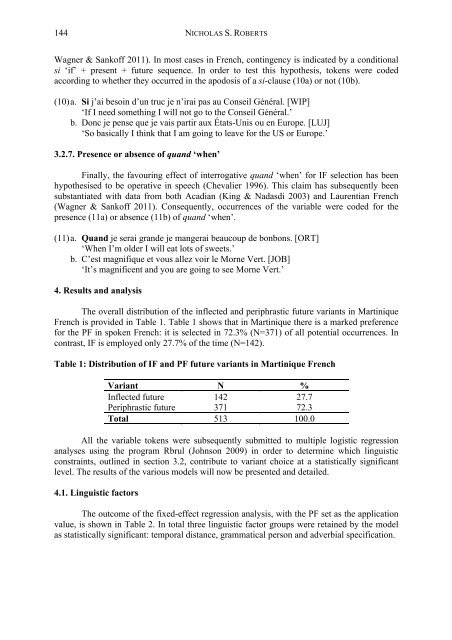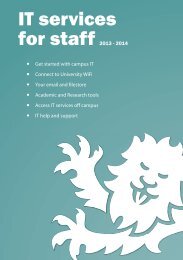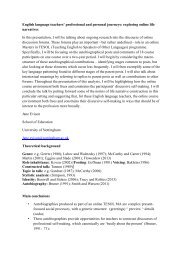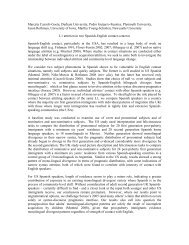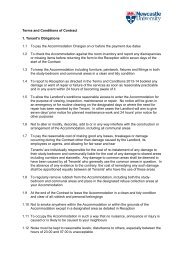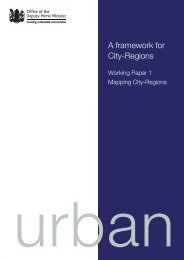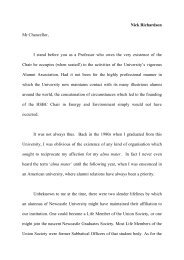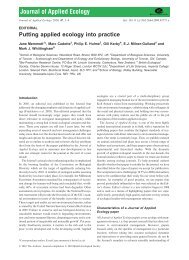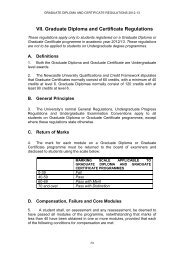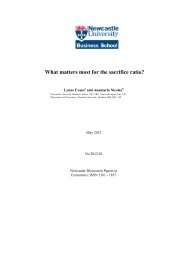the influence of linguistic factors on the expression of futurity
the influence of linguistic factors on the expression of futurity
the influence of linguistic factors on the expression of futurity
Create successful ePaper yourself
Turn your PDF publications into a flip-book with our unique Google optimized e-Paper software.
144<br />
NICHOLAS S. ROBERTS<br />
Wagner & Sank<str<strong>on</strong>g>of</str<strong>on</strong>g>f 2011). In most cases in French, c<strong>on</strong>tingency is indicated by a c<strong>on</strong>diti<strong>on</strong>al<br />
si ‘if’ + present + future sequence. In order to test this hypo<str<strong>on</strong>g>the</str<strong>on</strong>g>sis, tokens were coded<br />
according to whe<str<strong>on</strong>g>the</str<strong>on</strong>g>r <str<strong>on</strong>g>the</str<strong>on</strong>g>y occurred in <str<strong>on</strong>g>the</str<strong>on</strong>g> apodosis <str<strong>on</strong>g>of</str<strong>on</strong>g> a si-clause (10a) or not (10b).<br />
(10) a. Si j’ai besoin d’un truc je n’irai pas au C<strong>on</strong>seil Général. [WIP]<br />
‘If I need something I will not go to <str<strong>on</strong>g>the</str<strong>on</strong>g> C<strong>on</strong>seil Général.’<br />
b. D<strong>on</strong>c je pense que je vais partir aux États-Unis ou en Europe. [LUJ]<br />
‘So basically I think that I am going to leave for <str<strong>on</strong>g>the</str<strong>on</strong>g> US or Europe.’<br />
3.2.7. Presence or absence <str<strong>on</strong>g>of</str<strong>on</strong>g> quand ‘when’<br />
Finally, <str<strong>on</strong>g>the</str<strong>on</strong>g> favouring effect <str<strong>on</strong>g>of</str<strong>on</strong>g> interrogative quand ‘when’ for IF selecti<strong>on</strong> has been<br />
hypo<str<strong>on</strong>g>the</str<strong>on</strong>g>sised to be operative in speech (Chevalier 1996). This claim has subsequently been<br />
substantiated with data from both Acadian (King & Nadasdi 2003) and Laurentian French<br />
(Wagner & Sank<str<strong>on</strong>g>of</str<strong>on</strong>g>f 2011). C<strong>on</strong>sequently, occurrences <str<strong>on</strong>g>of</str<strong>on</strong>g> <str<strong>on</strong>g>the</str<strong>on</strong>g> variable were coded for <str<strong>on</strong>g>the</str<strong>on</strong>g><br />
presence (11a) or absence (11b) <str<strong>on</strong>g>of</str<strong>on</strong>g> quand ‘when’.<br />
(11) a. Quand je serai grande je mangerai beaucoup de b<strong>on</strong>b<strong>on</strong>s. [ORT]<br />
‘When I’m older I will eat lots <str<strong>on</strong>g>of</str<strong>on</strong>g> sweets.’<br />
b. C’est magnifique et vous allez voir le Morne Vert. [JOB]<br />
‘It’s magnificent and you are going to see Morne Vert.’<br />
4. Results and analysis<br />
The overall distributi<strong>on</strong> <str<strong>on</strong>g>of</str<strong>on</strong>g> <str<strong>on</strong>g>the</str<strong>on</strong>g> inflected and periphrastic future variants in Martinique<br />
French is provided in Table 1. Table 1 shows that in Martinique <str<strong>on</strong>g>the</str<strong>on</strong>g>re is a marked preference<br />
for <str<strong>on</strong>g>the</str<strong>on</strong>g> PF in spoken French: it is selected in 72.3% (N=371) <str<strong>on</strong>g>of</str<strong>on</strong>g> all potential occurrences. In<br />
c<strong>on</strong>trast, IF is employed <strong>on</strong>ly 27.7% <str<strong>on</strong>g>of</str<strong>on</strong>g> <str<strong>on</strong>g>the</str<strong>on</strong>g> time (N=142).<br />
Table 1: Distributi<strong>on</strong> <str<strong>on</strong>g>of</str<strong>on</strong>g> IF and PF future variants in Martinique French<br />
Variant N %<br />
Inflected future 142 27.7<br />
Periphrastic future 371 72.3<br />
Total 513 100.0<br />
All <str<strong>on</strong>g>the</str<strong>on</strong>g> variable tokens were subsequently submitted to multiple logistic regressi<strong>on</strong><br />
analyses using <str<strong>on</strong>g>the</str<strong>on</strong>g> program Rbrul (Johns<strong>on</strong> 2009) in order to determine which <str<strong>on</strong>g>linguistic</str<strong>on</strong>g><br />
c<strong>on</strong>straints, outlined in secti<strong>on</strong> 3.2, c<strong>on</strong>tribute to variant choice at a statistically significant<br />
level. The results <str<strong>on</strong>g>of</str<strong>on</strong>g> <str<strong>on</strong>g>the</str<strong>on</strong>g> various models will now be presented and detailed.<br />
4.1. Linguistic <str<strong>on</strong>g>factors</str<strong>on</strong>g><br />
The outcome <str<strong>on</strong>g>of</str<strong>on</strong>g> <str<strong>on</strong>g>the</str<strong>on</strong>g> fixed-effect regressi<strong>on</strong> analysis, with <str<strong>on</strong>g>the</str<strong>on</strong>g> PF set as <str<strong>on</strong>g>the</str<strong>on</strong>g> applicati<strong>on</strong><br />
value, is shown in Table 2. In total three <str<strong>on</strong>g>linguistic</str<strong>on</strong>g> factor groups were retained by <str<strong>on</strong>g>the</str<strong>on</strong>g> model<br />
as statistically significant: temporal distance, grammatical pers<strong>on</strong> and adverbial specificati<strong>on</strong>.


